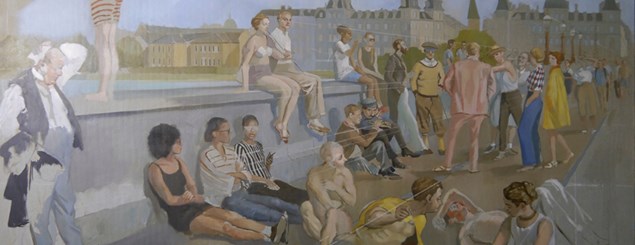CAPRICE - Thrándur Thórarinsson
In an idealized naturalism, the Icelandic-Norwegian painter Thrándur Thórarinsson portrays life in Reykjavik's and Copenhagen's various and often distinctive districts, bursting with sensory impressions and aesthetic stimulus.
Exhibition 19 May – 19 August
Thrándur Thórarinsson (Þrándur Þórarinsson) is an Icelandic-Norwegian painter, now resident in Iceland, but based in Copenhagen between 2011 and 2015.
Thórarinsson is an old school painter in the sense that he paints in the classical style of the old masters, but his subjects are contemporary. In recent years he has painted a number of urban landscapes of Reykjavik, and in this exhibition he also takes a fresh look at city life in Copenhagen, depicting not only the capital’s amusements and quirks, but also its darker aspects. The artist draws his inspiration from the city’s architecture, but casts a special spotlight on life in the city’s public spaces: more specifically the life between the buildings. Many of his paintings focus on the old urban districts, which were built ages before the advent of modernism and cars in the city. These districts grew out of the physicality and senses of the human body, and that makes us feel very much at home in them.
One example of this is car-free Christiania, which abounds in sensory impressions and aesthetic stimulus. In one series of paintings in the exhibition Thrándur Thrándursson subjects this district to investigation. But these paintings are not always exactly life-like. Instead, they depict the places as they might look, or as the painter would like them to look. This means he is applying the ancient principle of antiquity: the belief that an artist should beautify and elevate nature’s (or in this case the city’s) forms to create an ideal, which has absolutely nothing to do with reality or history. This could be defined as idealized naturalism or as visual wishful thinking. Harmony, balance, clean lines, order and a strict form best describe the idiom.
The exhibition also contains subjects drawn from Danish Golden Age painting, though shaped and adapted to contemporary settings. This is the artist’s way of creating a dialogue with his predecessors.
